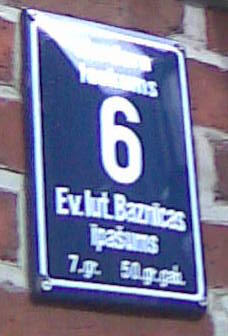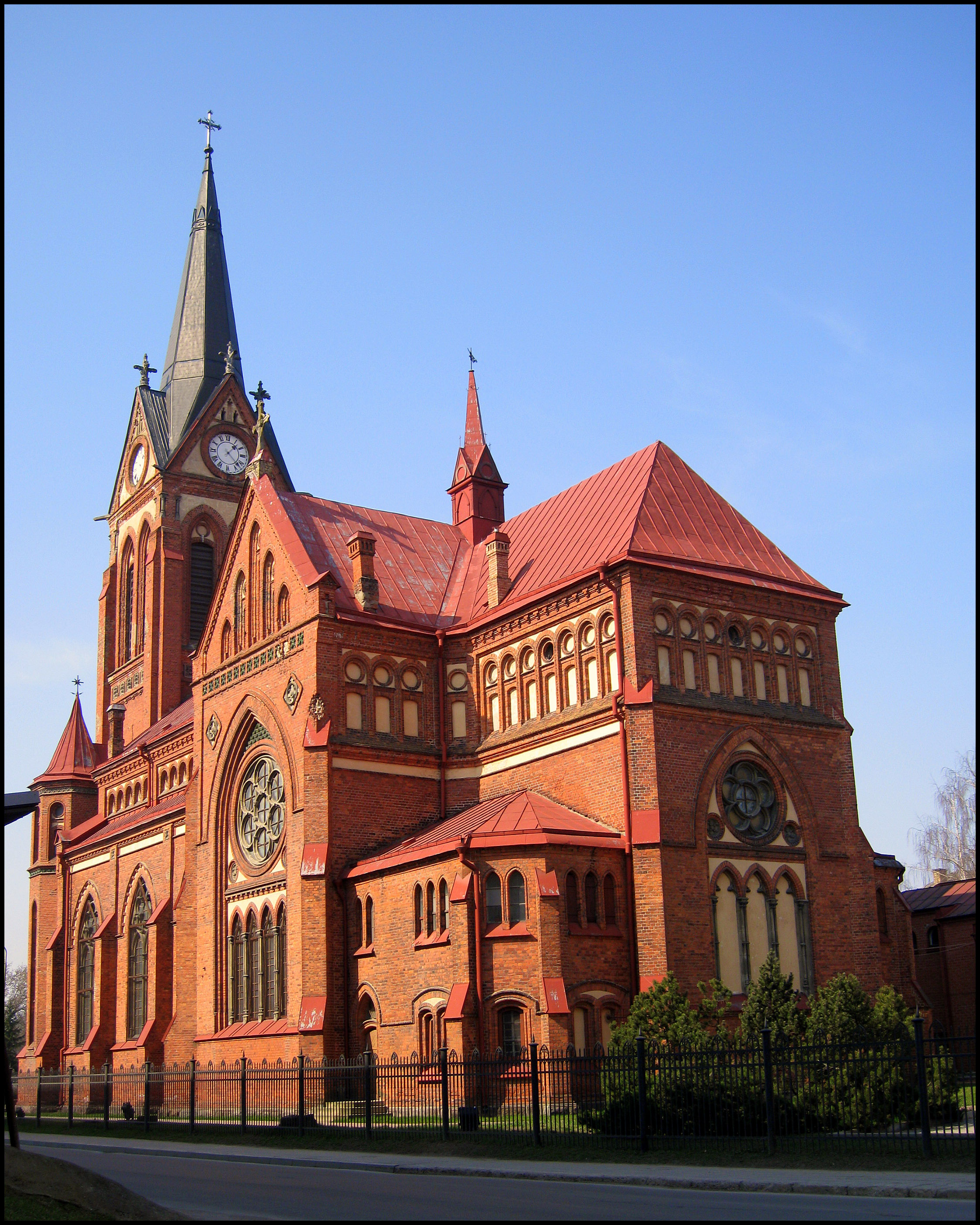|
1923 Latvian Church Property Referendum
A referendum on the transfer of church property was held in Latvia on 1 and 2 September 1923,Dieter Nohlen & Philip Stöver (2010) ''Elections in Europe: A data handbook'', p1122 the first time a referendum had been held in the country.Hiden, J (2004) ''Defender of minorities: Paul Schiemann, 1876-1944'', p92 Voters were asked whether the government should be stopped from transferring the Lutheran St James's Church in Riga to the Roman Catholic Church. Although a large majority voted for the proposal, voter turnout was well below the level required, and the church building was subsequently given to the Catholic Church.Nohlen & Stöver, p1135 Background The government led by Prime Minister Zigfrīds Anna Meierovics had started legislating for the transfer of Baltic German St James's Church to the Roman Catholic Church as well as forcing the Lutheran Church to share Riga Cathedral with the Catholics. The moves were vigorously opposed by Paul Schiemann, a prominent defend ... [...More Info...] [...Related Items...] OR: [Wikipedia] [Google] [Baidu] |
Riga Cathedral
Riga Cathedral ( lv, Rīgas Doms; german: Dom zu Riga) formally The Cathedral Church of Saint Mary, is the Evangelical Lutheran cathedral in Riga, Latvia. It is the seat of the Archbishop of Riga. The cathedral is one of the most recognizable landmarks in Latvia, and is featured in or the subject of paintings, photographs and television travelogues. Like all of the oldest churches of the city, it is known for its weathercock. The church is commonly called the Dome Cathedral, a tautology as the word 'Dome' comes from the German ''Dom'' meaning 'cathedral'. History and architecture The church was built near the River Daugava in 1211 by Livonian Bishop Albert of Riga, who came from Lower Saxony in northwestern Germany. It is considered the largest medieval church in the Baltic states. It has undergone many modifications in the course of its history. David Caspari was rector of the cathedral school in the late 17th century. His son Georg Caspari also served at the cathedral. F ... [...More Info...] [...Related Items...] OR: [Wikipedia] [Google] [Baidu] |
Latvia
Latvia ( or ; lv, Latvija ; ltg, Latveja; liv, Leţmō), officially the Republic of Latvia ( lv, Latvijas Republika, links=no, ltg, Latvejas Republika, links=no, liv, Leţmō Vabāmō, links=no), is a country in the Baltic region of Northern Europe. It is one of the Baltic states; and is bordered by Estonia to the north, Lithuania to the south, Russia to the east, Belarus to the southeast, and shares a maritime border with Sweden to the west. Latvia covers an area of , with a population of 1.9 million. The country has a temperate seasonal climate. Its capital and largest city is Riga. Latvians belong to the ethno-linguistic group of the Balts; and speak Latvian, one of the only two surviving Baltic languages. Russians are the most prominent minority in the country, at almost a quarter of the population. After centuries of Teutonic, Swedish, Polish-Lithuanian and Russian rule, which was mainly executed by the local Baltic German aristocracy, the independent R ... [...More Info...] [...Related Items...] OR: [Wikipedia] [Google] [Baidu] |
Dieter Nohlen
Dieter Nohlen (born 6 November 1939) is a German academic and political scientist. He currently holds the position of Emeritus Professor of Political Science in the Faculty of Economic and Social Sciences of the University of Heidelberg. An expert on electoral system An electoral system or voting system is a set of rules that determine how elections and referendums are conducted and how their results are determined. Electoral systems are used in politics to elect governments, while non-political elections ma ...s and political development, he has published several books. IDEA Bibliography Books published by Nohlen include: *''Electoral systems of the world'' (in German, 1978) *''Lexicon of politics'' (seven volumes) *''Elections and Electoral Systems'' (1996) *''Electi ...[...More Info...] [...Related Items...] OR: [Wikipedia] [Google] [Baidu] |
Evangelical Lutheran Church Of Latvia
The Evangelical Lutheran Church of Latvia ( lv, Latvijas Evaņģēliski luteriskā baznīca, or LELB) is a Lutheran Protestant church in Latvia. Latvia's Lutheran heritage dates back to the Reformation. Both the Nazi and communist regimes persecuted the church harshly before religious freedom returned to Latvia in 1988. In contrast to Estonia, where state atheism reduced the once 80% Lutheran majority to barely 10% by 2011, the Latvian Lutheran church saw its membership drop to around 20% but has recovered and now includes approximately 30% of the population. The church reports having 250,000 members according to the Lutheran World Federation. History The Evangelical Lutheran Church of Latvia sees itself as being in a continuous tradition of Christian life since the earliest recorded Christian missionary work in the area, in the 12th century. Latvia was highly influenced by the Reformation and the style of Lutheran church which emerged followed the more Protestant German-type ... [...More Info...] [...Related Items...] OR: [Wikipedia] [Google] [Baidu] |
Riga
Riga (; lv, Rīga , liv, Rīgõ) is the capital and largest city of Latvia and is home to 605,802 inhabitants which is a third of Latvia's population. The city lies on the Gulf of Riga at the mouth of the Daugava river where it meets the Baltic Sea. Riga's territory covers and lies above sea level, on a flat and sandy plain. Riga was founded in 1201 and is a former Hanseatic League member. Riga's historical centre is a UNESCO World Heritage Site, noted for its Art Nouveau/Jugendstil architecture and 19th century wooden architecture. Riga was the European Capital of Culture in 2014, along with Umeå in Sweden. Riga hosted the 2006 NATO Summit, the Eurovision Song Contest 2003, the 2006 IIHF Men's World Ice Hockey Championships, 2013 World Women's Curling Championship and the 2021 IIHF World Championship. It is home to the European Union's office of European Regulators for Electronic Communications (BEREC). In 2017, it was named the European Region of Gastronomy. I ... [...More Info...] [...Related Items...] OR: [Wikipedia] [Google] [Baidu] |
Roman Catholicism In Latvia
The Catholic Church of Latvia is part of the worldwide Catholic Church, under the spiritual leadership of the Pope in Rome. There are around 476,700 Catholics — around 22.7% of the total population. Catholics in Latvia are mainly found in the easternmost region of Latgale and most are ethnic Latgalians (modern), Latgalians. History The Catholic Church has been present in the area that now constitutes the Latvia, Republic of Latvia since Saint Canute IV in the mid-11th century brought Christianity to Courland and LivoniaSt. Canute IV ''Catholic Encyclopedia'', retrieved: 2007-04-28 and the first Christian church was built 1048 in Courland.Baznīcas vēsture 11. gadsimts ''catholic.lv'' ... [...More Info...] [...Related Items...] OR: [Wikipedia] [Google] [Baidu] |
Zigfrīds Anna Meierovics
Zigfrīds Anna Meierovics (, Durbe – 22 August 1925, near Tukums) was a Latvian politician and diplomat who served as the first Foreign Minister of Latvia from its independence until 1924 and again from December of the same year until his death. He also served two terms as the Prime Minister of Latvia from June, 1921 to January, 1923 and from June 1923 to January, 1924. He was one of the founders of the Latvian Farmers' Union, one of Latvia's oldest political parties. Early life Meierovics was born into the family of a Jewish doctor and his Latvian wife Anna, who died in childbirth. His father became mentally ill and therefore young Meierovics grew up with his uncle's family in Sabile. He studied at the Riga Polytechnicum. Career After 1911 Meierovics belonged to various Latvian organizations, notably the Riga Latvian Society. During World War I he worked in the Latvian Refugee Committee and the organizing committee of the Latvian Riflemen units. After the February Revolu ... [...More Info...] [...Related Items...] OR: [Wikipedia] [Google] [Baidu] |
Baltic Germans
Baltic Germans (german: Deutsch-Balten or , later ) were ethnic German inhabitants of the eastern shores of the Baltic Sea, in what today are Estonia and Latvia. Since their coerced resettlement in 1939, Baltic Germans have markedly declined as a geographically determined ethnic group. However, it is estimated that several thousand people with some form of (Baltic) German identity still reside in Latvia and Estonia. Since the Middle Ages, native German-speakers formed the majority of merchants and clergy, and the large majority of the local landowning nobility who effectively constituted a ruling class over indigenous Latvian and Estonian non-nobles. By the time a distinct Baltic German ethnic identity began emerging in the 19th century, the majority of self-identifying Baltic Germans were non-nobles belonging mostly to the urban and professional middle class. In the 12th and 13th centuries, Catholic German traders and crusaders (''see '') began settling in the eas ... [...More Info...] [...Related Items...] OR: [Wikipedia] [Google] [Baidu] |
Paul Schiemann
Paul Schiemann ( lv, Pauls Šīmanis; 17 March 1876 – 23 June 1944) was a Baltic German journalist, editor and politician who was known for his commitment to minority rights. Biography Carl Christian Theodor Paul Schiemann was born in Mitau in Courland, then part of the Russian Empire. He was educated in Germany, and underwent military training in the Imperial Russian army on the territory of what is now Lithuania. He came from a wealthy and conservative family (his uncle Theodor Schiemann, was a prominent supporter and historian of the German Empire), but his own political views were very liberal, and "made him an equally ardent opponent of both German National Socialism and of Soviet socialism." Schiemann started his education in Jelgava Gymnasium but later his father sent him to finish his studies in Elberfeld. After graduation he studied law and history in the universities of Berlin, Marburg and Konigsberg. However, he interrupted his studies when he was drafted into ... [...More Info...] [...Related Items...] OR: [Wikipedia] [Google] [Baidu] |
Concordat Of 1922
Concordat signed between the Latvian government and the Vatican on 30 May 1922 by Latvian foreign minister Zigfrīds Anna Meierovics, Zigfrīds Meierovics and Cardinal Secretary of State Pietro Gasparri. Ratifications were exchanged at the Vatican on 3 November 1922 by Latvian deputy foreign minister Hermanis Albats and Cardinal Gasparri, and the agreement became effective on the same day. It was registered in ''League of Nations Treaty Series'' on 16 June 1923. Terms of the agreement * Article 1 granted the Catholic Church in Latvia freedom to operate, as well as the status of corporate entity. * Article 2 required the Catholic Church to elevate its Diocese for Riga (reestablished in 1918) to an Roman Catholic Archdiocese of Riga, Archdiocese and stipulated all the Bishops should be of Latvian nationality. * Article 3 stipulated that the Archdiocese of Riga shall be under Vatican jurisdiction on all church matters. * Article 4 gave the Latvian government the right to veto every ... [...More Info...] [...Related Items...] OR: [Wikipedia] [Google] [Baidu] |
1931 Latvian Riga Cathedral Referendum
A referendum on the transfer of Riga Cathedral to the Lutheran Church was held in Latvia on 5 and 6 September 1931.Dieter Nohlen & Philip Stöver (2010) ''Elections in Europe: A data handbook'', p1122 Following a 1923 referendum the Lutheran Church had been forced to share the cathedral with the Roman Catholic Church.Hiden, J (2004) ''Defender of minorities: Paul Schiemann, 1876-1944'', p92 The referendum was passed by a large margin, and despite a voter turnout of only 32%, the government decided to proceed with the legislation.Nohlen & Stöver, p1135 The outcome of the referendum led to an increase in the popularity of civic parties in the parliamentary elections A general election is a political voting election where generally all or most members of a given political body are chosen. These are usually held for a nation, state, or territory's primary legislative body, and are different from by-elections ( ... in October. Results References {{Latvian elections 1931 re ... [...More Info...] [...Related Items...] OR: [Wikipedia] [Google] [Baidu] |



